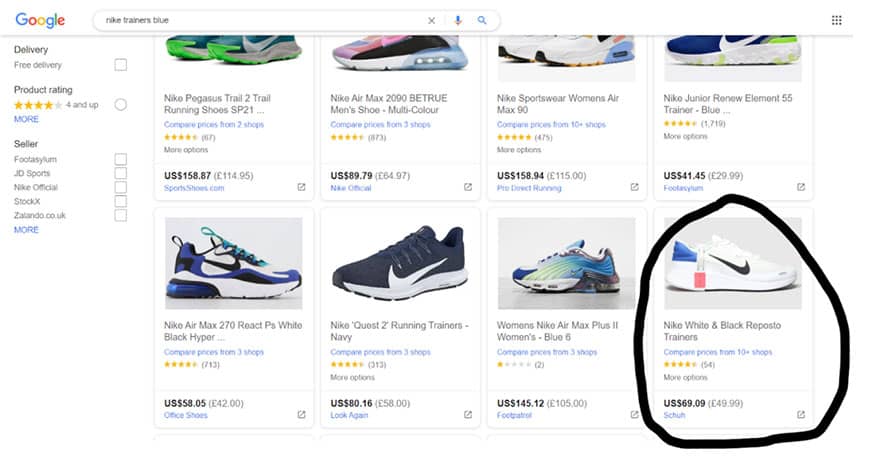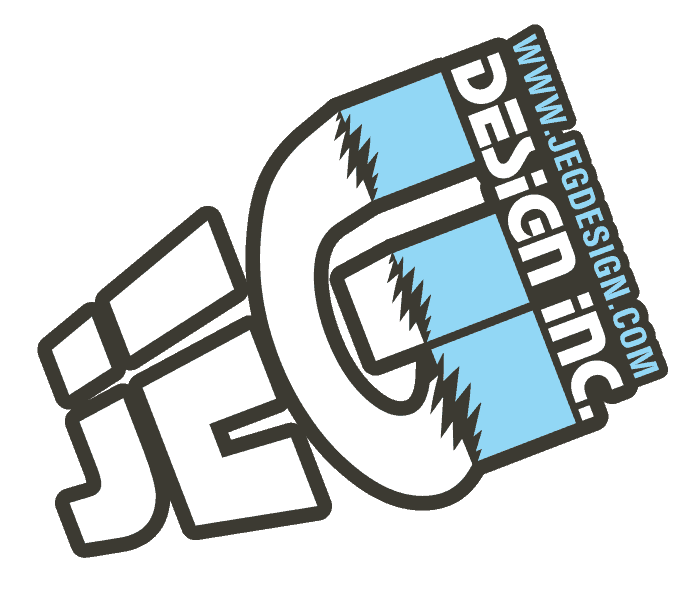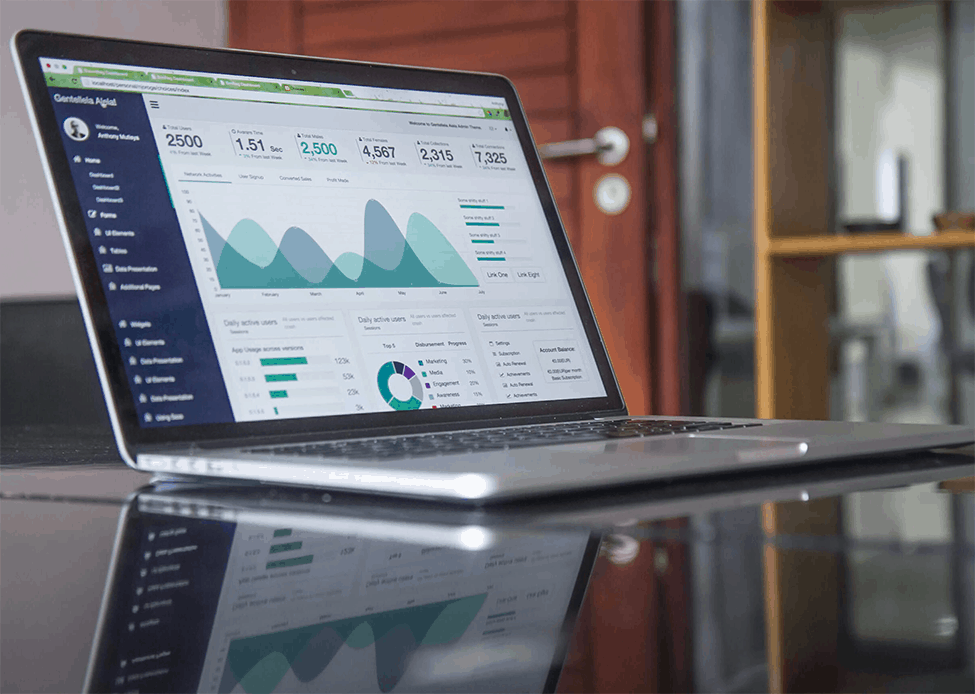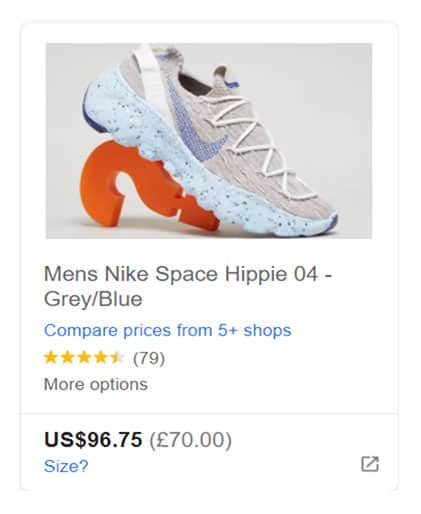When viewing products on Google Shopping, images are one of the things a potential buyer looks for first. In fact, 50% of online shoppers say images helped them decide what to buy. That highlights the integral role images play in deciding whether a purchase is completed. But how do we know whether our image is going to stand out or not?

Source: ThinkWithGoogle
In short, we don’t. But we can take a number of different approaches to optimize our images, so they get more focus than others. Here are the do’s and do not’s of Google Shopping images.
Why are Google Shopping images important?
Images are one of the most significant, and important elements of any Google Shopping advertisement. This is because they are one of the most visible segments of an ad, and also the first thing many customers see and look for. Images are also easy to understand, compare, and can beat any language barrier issues.
Many customers decide on a purchase using just 3 elements of a listing, the image, price, and title. This gives images extra significance and also presents merchants with an opportunity. This is because you have the possibility to create attractive images, within Google’s regulations, to attract customers to your listing, rather than that of your competitors.
The right image could ensure you are the one making those extra sales.
Google Shopping Image Requirements
Google Shopping has specific image requirements that merchants must fulfill in order to be allowed to list their items. If images do not meet those requirements, you will receive an error on your Google Merchant Center account. The image requirements are as follows:
Image Size:
- Non-apparel images: at least 100 x 100 pixels
- Apparel images: at least 250 x 250 pixels
- No image larger than 64 megapixels
- No image file larger than 16 MB
Image Format:
GIF (.gif) – *This must be non-animated
JPEG (.jpg/.jpeg)
PNG (.png)
BMP (.bmp)
TIFF (.tif/.tiff)
URL Format:
Google requires a URL for all images, due to its algorithm. URL requirements are as follows:
- Your URL must link to the main image for the product.
- All URLs must start with either http. or https.
- The URL must meet RFC 2396 or RFC 1738 guidelines, for example.
- Space would be %20
- A quotation mark (“) is %22
- A hashtag (#) is %23
Placeholder Image Regulations:
Placeholder images are prohibited, with two exceptions. They are:
- If the image is within the category of hardware or vehicle parts, illustrations are allowed when necessary.
- If your image is advertising paint you are allowed to use single color images.
What Not to Do with Your Product Images – Google Disapprovals
According to Google’s image requirements, there are a number of things that you cannot do with your images, due to disapproval. Here is a complete list of everything to avoid with your images:
Broken Links
Broken links due to an inaccurate URL will lead to your images not being shown at all. This is not only bad for your sales, and brand reputation, but will also lead to your product being disapproved eventually.
Watermarks
Whilst watermarks may help with promoting your product, Google wants every merchant to have a level playing field. Watermarks can also obstruct the view of a product. Therefore, watermarks and other promotional content are banned.
Inaccurate Images
Another reason Google disapproves product listings is if images are inaccurate. For example, if an advertisement for trainers shows a necklace, or if it is appearing in a search that is unrelated. This kind of image is not only misleading to customers, but to Google’s own algorithm.

Text on The Image
Google states that any additional text should go in your product description, rather than on the image. This is because text on an image can be distracting to customers who are browsing, and can also obstruct their view of the product.
Cluttered Images
Cluttered images, where it is unclear what item is actually the product does not make for a clever ad and will likely result in your product being disapproved. This is because it is potentially misleading to consumers, whilst also making the browsing experience on the Google platform far more difficult for them, and Google’s algorithm.
Single Colored Images
Unless you are selling paint, single colored images are not allowed and will cause your product to be disapproved by Google. This is not only because they are inaccurate, but also because they could make the market unfairly challenging to those actually selling paint produce.
Generic Images
Using no image at all, or a default image such as your company logo will lead to disapproval. All image content has to clearly show the product you are selling, and meet Google’s content guidelines.
10 Tips for Optimized Google Shopping Images
Ensure your product is the focal point of your image
Your product should always be the main focus of your image. Google’s regulations go a long way to helping to achieve this. However, you can also use a few of your own techniques to ensure your product attracts all the attention. This may include using different angles or lighting.
Use high quality images
Try to ensure any image you do use is of good quality. High quality images are all the more appealing to potential buyers, and they also seem more professional.
Ensure your image matches what you are selling
To make your product listings as relevant and appealing as possible, one of the best practices is to include images in your product feed that always match what you are advertising on shopping channels. any platform. Google Shopping is no different in that regard. If you are advertising a specific product variant, then the picture should show that variant. For example, if you are selling blue Nike trainers, do not show an image of the same trainers in red. This may deter customers and will almost definitely get a markdown from Google’s algorithm.
Use a range of image angles
You could have the perfect image for your product, but if you only show it from a single angle, many potential buyers may be put off. This is because customers like to be able to see exactly what they are buying. A single angle can often make that a challenge for them. Therefore, by including images from numerous angles, you can show your customers exactly what it is you are selling, in the clearest way possible.
Pay attention to the background and lighting
Background and lighting are a great way to help your image stand out from the competition. Try to use a simple background that will help to highlight your product. The background should contrast with the color of your item, without taking away from it. You can also use lighting to dim the areas around your product and illuminate the area around it.
Give your images a retouch
Even if you have a high quality image, it is always worth taking a little time to try to retouch it a bit so your ads truly stand out. If you are an Apple user you could check out Instasize for instance which has a paid and free version. You never know, you may be able to make it that little bit clearer, which is all the more appealing to your audience.
Follow Google’s image requirements and avoid rejection
We have mentioned Google’s image requirements earlier, but what we didn’t mention is how rejection can cause issues for your Google Shopping campaigns in the long run. When Google disapproves of one of your products for not meeting their requirements, it considers this a violation. If product disapproval is a regular occurrence, it can impact your future campaigns as Google may place limitations on your Merchant Center account.
Utilize additional images
Additional images are a great way to showcase your product in a variety of different ways. This could be from different angles, or in different lighting, as mentioned before. However, it could also show them at different zoom rates, or even in use. Additional images can be used to suit your product, and give customers a greater understanding of exactly what it is you’re selling.
Use lifestyle and product images
Different products sell better with different types of images. Some products sell better with product images, which are simply images of the item you are selling. Whilst others, such as clothes, may sell better with lifestyle images. This is when the product is being used in the image to highlight how it looks or what it does.
As you have the opportunity to add additional images on Google Shopping, you may even find that you get the best results when you use a combination of the two image types. Try to A/B test which type of image works best for your products.

Source: DataFeedWatch
Do Regular A/B Testing
By conducting regular A/B testing on all your product listings, you will be able to gain an understanding of which images perform better than others. You should make sure to continue to do testing regularly, even if your product is performing well. This is because the market can change at all moments, due to competitors and outside environmental factors. And after all, you never know when you may find an even better way of showcasing your product to the world.
Final Thoughts
Your Google Shopping images are a significant part of selling on the platform. So by ensuring they meet all the requirements, and are fully optimized, you increase your chances of getting noticed.
And remember, by testing regularly, and staying on top of Google’s ever changing image parameters, you can ensure your images don’t fall into neglect.
About the Author
 Jacques van der Wilt is the founder and CEO of DataFeedWatch, a leading global feed management and optimization solution that helps online merchants optimize their product listings for 1,000+ ecommerce channels in more than 50 countries.
Jacques van der Wilt is the founder and CEO of DataFeedWatch, a leading global feed management and optimization solution that helps online merchants optimize their product listings for 1,000+ ecommerce channels in more than 50 countries.




